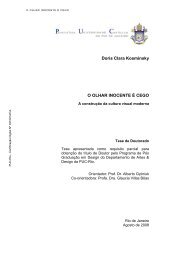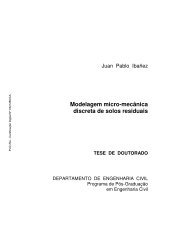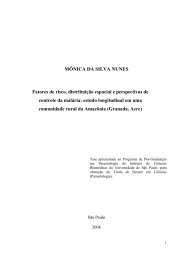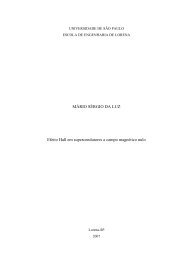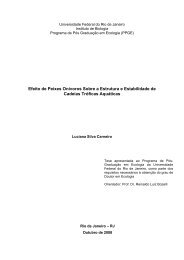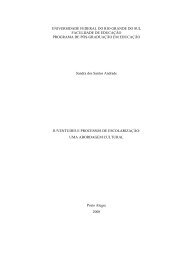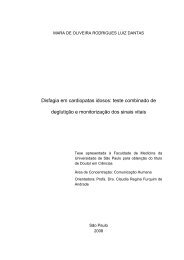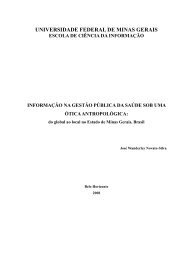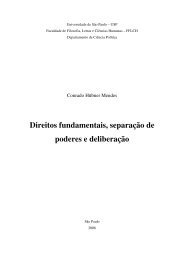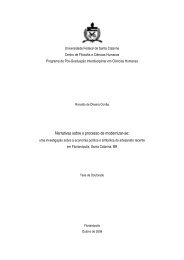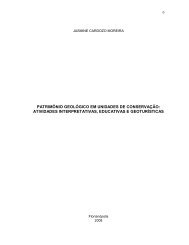Create successful ePaper yourself
Turn your PDF publications into a flip-book with our unique Google optimized e-Paper software.
R. Sousa Car<strong>do</strong>so et al.induced in the microarray experiments and the <strong>AIRE</strong><strong>gene</strong> (acc NM_009646) were tested by SQ RT-PCR; 1 lgtotal RNA from each developmental phase in FTOCwas copied to cDNA by reverse transcription usingoligo-dT(12-18) as a primer. One microlitre of successivedilutions of the cDNA (1 : 2 to 1 : 128) were used as aPCR template. PCRs were performed in a final volumeof 25 ll containing 100 lM each dNTP, 1 lM eachprimer and 1 U Taq DNA polymerase (AmershamBiosciences).The amplification protocol for the ZNF 369 and <strong>AIRE</strong><strong>gene</strong>s assayed was as follows; one cycle at 94° for 5 min,30 cycles of 94° for 1 min, 55° for 1 min, then 72° for1 min, and then one cycle at 72° for 10 min then 4° for10 min. The amplification was terminated with a finalincubation step at 72° for 10 min.Aliquots of the PCR products were mixed with 1 ll ofa diluted solution of ethidium bromide, resolved on 2%agarose gel electrophoresis using 1 · TAE buffer. The gelswere visualized on a UV transilluminator and the imageswere captured using a digital camera.The PCR primers were identified using the PRIMER3 software(http://fro<strong>do</strong>.wi.mit.edu/cgi-bin/primer3/primer3_www.cgi) on the cDNA sequences retrieved from GenBank(http://www.ncbi.nlm.nih.gov) for each <strong>gene</strong>. The forwardand reverse sequences are given in the 5 0 to 3 0 orientation;ZNF 369 (clone ID 573600, GenBank acc NM_178364)(GGGAGGACCTTATGTGTGT and GGGGCTCTCCTTATCCAAAAG) and the autoimmune regulator <strong>gene</strong>, <strong>AIRE</strong>(GenBank acc NM_009646), although not included in themicroarrays, was also assayed with the following primers(CATCCTGGATTTCTGGAGGA and GCTCTTTGAGGCCAGAGTTG).ResultsGenes differentially expressed during FTOCdevelopmentTo identify significant changes in <strong>gene</strong> expression duringfetal development in FTOCs, the early thymus at 15 dayswas compared with those observed on the subsequentdays (15 versus 16, 15 versus 17 and 15 versus 20 daysp.c. FTOC). A scatter plot of the observed relative differenced(i) against the expected relative difference d E (i) wasused, as shown by the SAM program.Most of the 9216 sequences tested presentedd(i) + d E (i), indicating that their expression patternremained unchanged; however, some <strong>gene</strong>s were significantlyrepressed (154 <strong>gene</strong>s) or induced (38 <strong>gene</strong>s) duringFTOC development (Fig. 1).Interestingly the induction of the 38 <strong>gene</strong>s that includerepresentation of parenchymal organs in the thymus, thuscharacterizing PGE, was observed at late FTOC (20 daysp.c.) (Table S1).Genes differentially expressed80706050403020100RepressedInduced15 vs 16 15 vs 17 15 vs 20 15 vs 20Comparisons during FTOC development (days p.c.)Figure 1. Differential <strong>gene</strong> expression during the development ofFTOC showing that induction of tissue-specific <strong>gene</strong>s emerges at20 days. Staging corresponds to development of fetal thymus in culture;15 days FTOC ¼ 13 days gestation thymus plus 2 days inFTOC.Gene expression assessed by SQ RT-PCRThe ZNF 369 <strong>gene</strong> (acc NM_178364) was selected to confirmthe respective result obtained with the cDNA microarray.SQ RT-PCR evaluation confirmed that this <strong>gene</strong>was induced at 20 days p.c. FTOC (Fig. 2a). Moreover,the <strong>AIRE</strong> <strong>gene</strong> (acc NM_009646) began its expression at16 days p.c. FTOC (Fig. 2b).Parenchymal organ representation in the thymusThe 38 <strong>gene</strong>s identified as significantly induced at 20 daysp.c. in FTOC were assigned to 57 parenchymal and sevenlymphoid organs according to their pre<strong>do</strong>minant expression,which were subgrouped in 17 systems. Interestingly,central nervous and reproductive systems and glands arethe pre<strong>do</strong>minant parenchymal organs represented in thethymus at this phase of development, followed bythe lymphoid system (Fig. 3). Four <strong>gene</strong>s; small nuclearribonucleoprotein D1, acc NM_009226; CD27 antigen,acc L24495; Riken cDNA 1110065L07, acc AA119642;and D-amino-acid oxidase, acc AI447515; code for tissuespecificantigen proteins, because they are expressed inonly five or six tissues (Table S1).(a)1520(b)1:115DILUTIONS1:2 1:4 1:8 1:16 1:32 1:64 1:128F T O C16Figure 2. Semi-quantitative reverse transcription-PCR. Confirmationof ZNF <strong>gene</strong> as induced at 20 days FTOC (a) and emergence of<strong>AIRE</strong> <strong>gene</strong> expression at 16 days FTOC (b).1720372 Ó 2006 Blackwell Publishing Ltd, Immunology, 119, 369–375



